The following newspaper reports and pictures are derived from a team scrapbook put together by Nickie Leyen..
February 19, 1990 Convict Lake, fall through ice
From Los Angeles Times newspaper report by Tracy Wilkinson and Joel Sappel
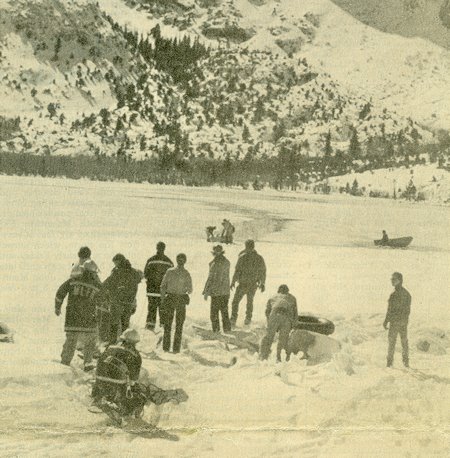
Volunteers help tug a rubber raft from the ice hole in the center of Convict Lake back to shore. bystanders watched in stunned shock as only one person was brought out of the raft - after four peole had been visible at one point floundering in the water - Review-Herald/Pierre LaBossiere Photo
CONVICT LAKE, Calif.-The screams first were heard about noon Monday out on Convict Lake.
And soon the word spread. Four teen-age boys and two counselors from nearby Camp O'Neal had been hiking across thin ice and fallen into the water. Twelve teenagers and two adults from the residential facility for troubled youths had been on a holiday outing.
With the ice cracking beneath them, frantic rescuers crawled toward two openings in the frigid water of Convict Lake where the drowning teenagers and their counselors grasped desperately for life. Three teenagers and the counselors could not be saved.
And swiftly, the efforts to rescue them became a treacherous struggle by rescuers to save each other, according to interviews with rescuers and eyewitnesses.
Clay Cutter of the U.S. Forest Service, who lived nearby, was one of the first to rush to the scene of the accident. Steadily but carefully, he made his way on hands and knees toward the center of the lake. One unidentified teen had pulled himself out, but the other three youngsters had apparently already drowned; they were no longer in sight.
Cutter was able to reach the two counselors, their heads bobbing, their arms thrashing. Perched precariously at the edge of the ice, he managed to put a rope around each man while talking to them continuously to keep them calm.
Meanwhile, summoned by their beepers, members of the Long Valley volunteer fire department hurried to the lake.
Cris Baitx, chief of the department, and Ray Turner, a captain, grabbed an aluminum flat-bottom boat and pushed it out over the ice. Suddenly, the ice broke under Turner and he fell into the water. Baitx pulled Turner back into the boat.
Crouched on a ladder to distribute his weight, Baitx pushed himself slowly over the ice toward the victims. He reached one of the counselors, known to the rescuers as "Grandpa," and started to hoist the man to safety.
Suddenly, the ice collapsed underneath them and Baitx fell into the water alongside Grandpa. Baitx, recalling the accident Tuesday from his home in Mammoth Lakes, said he found himself trapped under ice.
"I had to beat the ice out with my hands," Baitx told The Times on Tuesday. "I was sure I was gone. I was thinking of my wife and kids and are they going to be OK, because I'm history."
At this moment, volunteer fireman Vidar Anderson reached the lake and, using two ladders for better weight distribution, shimmied toward where Baitx had fallen.
Anderson grabbed Baitx-but the ice cracked again and both men plunged into the water.
"At that point, I went down again," Baitx recalled. "head-butted the ice and busted through."
Baitx would go down a third time before being rescued; Anderson, 58, would not be seen again.
Meanwhile, Cutter, too, was having difficulties. As he struggled to assist the counselors, he had slipped and fallen into the water.
"We would see a head above water, then you didn't see that head," said one of a score of horrified spectators--including Cutter's wife--who watched the operations from the lake's shore. "There would be two heads, then one. Then no one. You knew what was going on."
By this time, Russ Veenker, a diver for the June Lake Search and Rescue Team, had' arrived. Pulling a rubber raft behind him, he delicately walked onto the ice, past where Turner sat in the flatboat, tugging on a single lifeline to Baitx.
The ice cracked under Veenker's footsteps, Turner recalled.
Veenker first reached Baitx, now semiconscious, purple in color. He pulled Baitx from the water, lay him across his chest to float and stabilize him, then set him in the raft.
Then, recalled Baitx and other witnesses, Veenker turned to the other men who had been struggling to stay afloat-but no one was there. It was too late for Cutter, Anderson and the two counselors. They had lost the battle to keep their heads above water.
"They kind of lost [Cutter] right at the last," said Remington Slifka, general manager for the Convict Lake resort, who watched the futile rescue. "The diver said he thought he had him, that he really tried to hang on, but he was gone."
In the first minutes after the men and boys fell into the water, the other youngsters from Camp O'Neal continued to run out onto the ice in a panicked attempt to reach their friends.
Some would lie on the ice and try to reach into the water-until they were so soaked they had to turn back, sheriffs investigators said.
Only after rescuers warned them of the dangers could the boys be restrained. They paced the shore, watching helplessly.
"The kids were hysterical," said a 31-year-old maintenance worker from the resort who witnessed the tragedy. "Their friends were under there. They saw them dying."
All involved-the children, other counselors and many of the surviving rescuers-found themselves Tuesday grappling with feelings of anger, of guilt for having lived when close friends died, of grief.
"It was a bad scene and just kept getting worse." Baitx said. "Everybody was trying their best-but nothing was working."
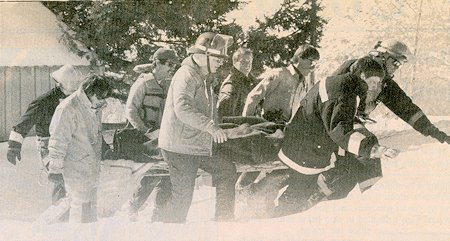
Long Valley Volunteer Fire Chief Chris Baitx is carried from the icy waters of Convict Lake after he tried to help victims who were lost. - Inyo Register/Pierre LaBossiere
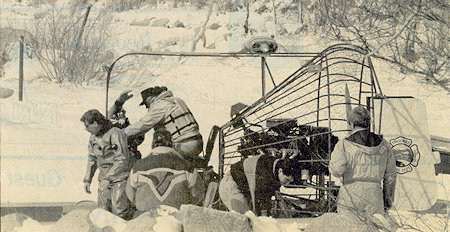
A rescue crew from Truckee Volunteer Fire Department, 200 miles north, joined the efforts at Convict Lake on Tuesday - Inyo Register/Martin Forstenzer
From Los Angeles Times newspaper report by Kevin Roderick and Sheryl Stolberg
Divers Pull 1 of 7 Bodies From Icy Sierra Lake - Sheriff says all the victims may not be found. Meanwhile, close-knit community is in shock.
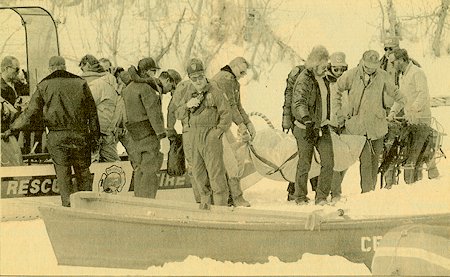
Rescue personnel remove body of victim from icy Convict Lake in the Sierra Nevada, as divers continue to search nearby. Six others died - Thomas Kelsey/Los Angeles Times
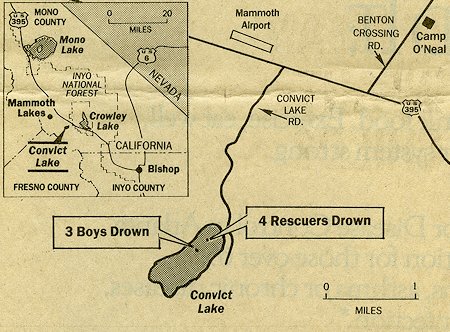
Los Angeles Times
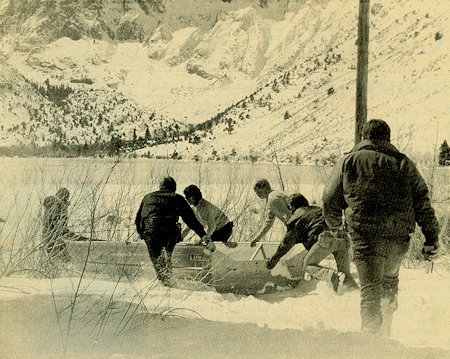
This rowboat was cut loose from the shore of Convict Lake during the early moments of the rescue. The boat was apparently too heavy to be dragged through the ice however, and Chris Baitx and Vidar Anderson eventually crawled to the scene on their knees. The two tiny figures on the ice in the upper left-hand corner of the photo are two rescuers - one of whom was Clay Cutter - who later fell through the ice and died. - Review-Herald/Pierre LaBossiere
CONVICT LAKE, Calif.-Rescue teams pulled the first of seven bodies from the frigid waters of this eastern Sierra Nevada fishing lake Tuesday, as friends of the drowning victims kept vigil at lakesie and counselors moved in to assist survivors at a youth camp that lost three students and two adult employees in Monday's tragedy.
Throughout the day, divers clad in bright blue rubberized suits probed under a cap of ice for the bodies of the victims, who had not been seen since they slipped beneath the lake's surface shortly after noon Monday. Other rescue workers manned helicopters and a special "airboat" that skimmed over the treacherously thin ice.
The body discovered was that of U.S. Forest Service Ranger Clay Cutter, whose wife Terry had watched as her husband ran across the frozen lake to try to aid three floundering teen-agers-only to be trapped himself when the ice collapsed. Cutter was followed by three other would-be rescuers, who also drowned.
Outside the Cutters' lake-front home Tuesday, friends sobbed as rescue workers lifted the body into the airboat and enclosed it in a yellow bag. Cutter's body was recovered after rescue divers found a rope floating on the lake's surface. They pulled at the line, and found Cutter at the end, according to one rescuer, Lt. Glenn Barnes of the Washoe County, Nev., Sheriff's Department. Cutter's hand, he said, was still tightly clasping the nylon rope.
As delicate recovery work proceeded on the ice, California Air National Guard crews combed the perimeter of the lake. Officials said they were responding to statements by witnesses who said they saw one of the seven victims make it to shore. But no evidence was found of a survivor.
"We searched the perimeter real thoroughly and we didn't see anything," said Maj. Steve Hussey, who is attached to the reserves at Moffet Naval Air Station near San Jose.
Mono County Sheriff's Investigator John Rutkowski indicated that the investigation into the deaths was only beginning.
"These are the things we're trying to find out: How much supervision did they have? Were they out on the ice alone? How many were out on the ice at one time?"
The sheriff's office and other agencies, meanwhile, began releasing the names of the dead.
The tragedy, among the worst of its kind in the nation in at least a decade, began at noon Monday when a handful of teen-agers from Camp O'Neal, a private probation camp across U.S. 395 from the lake, ventured out onto the newly frozen surface. The camp handles troubled teen-agers from several counties.
As they played on the ice, four of them suddenly fell through. One managed to clamber out and three were trapped in the frigid water. Authorities identified the dead youngsters as David C. Sellers, 15, of Tulare and Shawn Diaz, 15 of Dinuba, and an unnamed 13-year - old from Redlands. The 16-year-old who escaped the frigid lake was not identified.
In addition, Mono County Sheriff Martin Strelneck identified two of the adult victims, Dave Meyers and Randy Porter, as camp counselors who had tried to rescue the teen-agers. The other victims were two rescue workers-volunteer fireman Vidar Anderson of Sunnyslope and Forest Ranger Cutter.
Another volunteer firefighter who survived several minutes in the frigid water was released Tuesday from Centinela Mammoth Hospital in Mammoth Lakes, about five miles north of here.
Shortly after his release, Chris Baitx told The Times that he had to punch through the ice three times to grab breaths of air as rescuers crept toward him.
"It was a bad scene and it just kept getting worse," he said. Baitx, part of a volunteer force that arrived well before better-equipped rescuers, said he felt he had to reach out to the floundering youths and counselors despite the risk.
"Just watching these heads bobbing up and down was too much," Baitx said.
"We figured we should have waited for the rescue team. But when people are bobbing up and down, you know what's next."
The search for victims had been called off at dusk Monday because of fears that more would be lost to the lake. But at 7 a.m. Tuesday, new rescue teams began converging on the Mammoth Lakes sheriff's substation. Within two hours, an aircraft from the China Lake Naval Weapons Station was circling the lake, pinpointing with buoys and weighted ropes the holes where the victims had disappeared.
The airboat from the Truckee Fire District and a special diving team from Washoe County then moved onto the ice, recovering the first body by 11 a.m. and searching throughout the day for others.
Mono County Sheriff Strelneck said the chances of finding all of the bodies are slim, given the lake's depth and the dangerous conditions. As if to emphasize that, the skies, clear and wind-free at dawn, had clouded over by noon.
"We think it will be a very difficult operation," Strelneck said.
The conditions remained treacherous and the progress frustratingly slow all day Tuesday. Divers were limited to 15 minutes in the icy water because of the cold and the effects of the high altitude.
The first of three crews to dive under the ice Tuesday was forced to return to the surface after only six minutes, when the air regulators on their diving equipment froze. The malfunction sent compressed air streaming from the tanks, endangering the divers.
"I was down for about six minutes and it will be three hours before I'm able to dive again," said Carl Barrett of the Washoe County sheriff's diving team. Divers were forced to stay out of the water after each dive until their blood gases returned to normal, he said. Barrett and his partner were diving in about 77 feet of water near where the adult rescue workers were believed to have fallen through the ice, he said. Visibility was 12 to 15 feet, but Barrett said no bodies were visible.
"Nothing but sand, nothing," he said when asked what he saw.
Divers were sent down in teams of two from a rubber boat, which carried other diving team members who monitored the safety of their colleagues. During the attempts Tuesday, divers began at the points where victims were believed to have fallen, and slowly worked their way outward in a circular pattern.
Sheriff's deputies said they believe the bodies may have sunk to the bottom of the lake, which is up to 140 feet deep. The Washoe County team is able to dive only to depths of about 80 feet, forcing local officials to call for assistance late Tuesday from the Los Angeles County sheriff's rescue team. Its equipment allows dives of up to 300 feet, officials said. The team was scheduled to depart Los Angeles on Tuesday night.
Skaters and hikers often test the frozen lake, as the camp youths apparently did on Monday, local officials said.
"People do that and get away with it quite often," said Mono County Sheriff's Lt. Terry Padilla.
"This is an at-your-own-risk sort of thing," added U.S. Forest Service employee Dave Reider.
In the close-knit Sierra community, the impact of the deaths hit home Tuesday.
"The town is in shock right now," said Mammoth Lakes town manager Paul Marangella. "This accident has touched everyone. . . . Most of us know each other. Any kind of tragedy like this has a tremendous effect."
At Camp O'Neal, a spokesman firmly turned away inquiries. He said residents and counselors were undergoing therapy Tuesday with specialists.
"What we're going through is real tough," the spokesman said.
Mono County Sheriff's Investigator John Daniels, who interviewed some of the teen-agers who had been on the lake, said they displayed a wide range of emotions.
Some adopted a tough, stoic posture to appear like "hardened young boys," Daniels said.
Others took the tragedy harder, Daniels said. "Some had lost their best friends."
Among friends and relatives of the other victims, grief was slightly more public. Cutter, who was in his mid-30s, worked as a ranger for the U.S. Forest Service during the winter; in the summer he was a Forest Service firefighter. His supervisor, Dean McAlister, said Tuesday that Cutter had rescued people from the lake before.
On Monday, friends said, youngsters had banged on his door to warn him about the struggling teen-agers. He left his house with the black-and-red rope he had used on earlier rescues, the same rope that led to the discovery of his body on Tuesday.
His wife, Terry, had run to the shore and watched through binoculars Monday afternoon as her husband struggled to rescue the victims. As his body was pulled from the lake Tuesday, she remained in seclusion.
"This is hard to believe, especially when it's someone you know, someone you worked with," said Tim McMullen, a fire management officer for the Inyo National Forest.
Cutter's friends, standing vigil at the lake, praised his courage. "He would do anything to save a person's life," said Marsha Reiten.
Friends of the other adult rescuer, volunteer firefighter Vidar Anderson, also rallied around his family. Anderson, a retired school bus driver, lived in nearby Sunnyslope with his wife, daughter and granddaughter.
"He was one of the truly great friends the fire department had," said Mono County Sheriff's Deputy Paul Burns.
Few knew the names of the victims Monday night, but when the names of the dead were released Tuesday, the shock broadened.
"Everyone in town lost a friend in this thing," said Remington Slifka, general manager of the Convict Lake Resort.
Slifka and others who stood on the shore as the clouds rolled in Tuesday said the lake's dangers should have been well known to the locals. Convict Lake is fickle, they said. A week ago it was frozen over, but this past Saturday most of the ice was gone. It did not freeze again until Sunday night, Slifka said.
From Review-Herald newspaper report by Jeff Putman and Pierre LaBossier

When the national press corps began arriving in Mono County early Tuesday to cover the Convict Lake disaster, Sheriff's Department Lt. Terry Padilla drew the unenviable task of coordinating the release of information, which was slow to come in. Shown here shortly after the body of U.S. Forest Service Ranger Clay Cutter was recovered from Convict's icy depths, Padilla dispensed the news matter-of-factly, then coordinated the "pooling" of video footage obtained by a cameraman chosen by the TV journalists
Sierra mourns loss of 'heros' Flags flew at half-mast throughout Mono County on Wednesday, as the entire Eastern Sierra mourned the loss of four true heroes.
Risking their own lives in a valiant - though ultimately futile - effort to save three Camp O'Neal youngsters who plunged into the icy waters of Convict Lake Monday afternoon, the men put the welfare of the kids and their fellow rescuers ahead of their personal safety.
Reports indicate that at least one and possibly two lives were saved as a direct result of their heroism. But Vidar Anderson, Clay Cutter, David Meyers and Randy Porter - and their families and friends - paid the ultimate price in return. They lost their lives.
Anderson, a captain with Long Valley Fire Department, was among the victims. Daughter Tina Anderson on Tuesday described her dad as a man so committed to emergency service he sometimes bordered on the reckless.
"Sometimes we'd be kind of mad that he risked his life," she explained. "My mom and I would be petrified. He'd go out in the worst weather. He always had to be the first one at the scene. He had no fear."
Tina said the all-volunteer Long Valley Fire Department had recently promoted Anderson to captain, in part to keep him from being the first one on-site, doing it all.
"They were hoping to protect him," she said.
That strategy failed Monday.
Anderson was on the scene quickly, but both he and fellow volunteer Chris Baitx were plunged into the icy waters when the thin ice broke around them. Only Baitx survived.
The Anderson family lives at Sunny Slopes where Vidar, 58, was a pillar of the community. He served seven years on the Long Valley Fire Protection District, and did a stint on the local water district's governing board. He also drove a bus for Mammoth High School for several years.
Convict Lake resident Clay Cutter also died in Convict Lake's icy waters while attempting to save the youths. He was chopping wood in front of his house when other boys on the lake outing ran up to him for help, according to his neighbor, Remington Slifka.
By the time Slifka and a friend grabbed blankets and headed for the ice, Cutter was already out on the lake with a rope. His attempt to save the youths cost him his life when he broke through the ice.
Cutter worked as a firefighter for the Mammoth Ranger District of the Inyo National Forest. According to District Ranger Dean McAlister, Cutter become a permanent Forest Service employee last summer after several summers with various districts on the Inyo. This winter, he had operated snowplows for the Forest Service.
Cutter, his wife, Terry, and their three children, Deena, Crystal and Lisa, lived in a government-owned house at the lake. Slifka said he enjoyed seeing the Cutter family at the nearly-vacant lakeshore community.
"Clay was very brave in his own way," Slifka said, describing Cutter as an outdoorsy, "typically macho type of guy."
A memorial service will be held for Cutter at 10 a.m. Friday at the U.S. Forest Service Visitor Center in Mammoth Lakes.
While less is known about the two Camp O'Neal counselors and the three boys who apparently perished in the incident, camp Executive Director Bobbi Trott said the school is none-the-less in "shock" and "disbelief' over the deaths.
"The kids are doing okay," she said, "(but) they're not doing great. These kids already have problems, and this will add to it."
"A lot of the younger kids believe they're still alive," Trott added.
Trott says the Camp O'Neal staff and students are undergoing therapy in an effort to help them deal with the tragedy psychologically.
Trott said Meyers was called "Granpa" by the Camp O'Neal kids.
"He was just a neat guy. He was always hugging the kids," Trott said. "He became the special person that a lot of these kids didn't know."
Trott said Meyers was an avid backpacker and hiker.
Porter had just started as a counselor at the camp, Trott said. He had an extensive background in residential treatment, and was also a hiking enthusiast.
Porter, his wife Cathy and 7-year-old son moved to the June Lake area from La Habra in April of last year, "jumping" at the chance to move here from Southern California. Family friend Ellen Thomas said Wednesday that Porter was an avid fisherman and outdoorsman.

A snapshot of volunteer fireman Vidar Anderson
From Los Angeles Times newspaper report by Joel Sappell and Jenifer Warren:
Rescuer's Death Is Dark Day for Sunny Slope SUNNYSLOPE, Calif - Most of his friends figured he would die a hero, because when disaster erupted in the eastern Sierra Nevada, Vidar Anderson was always there.
Forest fires, plane crashes, mountain rescues-these were like a call to arms for Anderson, 58, a volunteer member of the Long Valley Fire Department. Tall and wiry, the retired school bus driver would invariably be the first on the scene. He was aggressive, friends and colleagues said, selfless, and ever calm in the face of danger.
"He was fearless," Ray Turner, a fellow firefighter, recalled Tuesday as he sat in the local fire station, weary, grimy and subdued. "He would risk his life in a minute."
On Monday, Anderson met his match on the treacherous, frozen surface of Convict Lake. As he struggled to reach three teen-agers floundering frantically in the frigid waters, Anderson crashed through the ice, slipping into the dark of the mountain lake.
A diver from the June Lake search and rescue team managed to slide a rubber boat across the ice and save another would-be rescuer, Chris Baitx, but Anderson had dropped from sight before he could be reached.
News of his death struck like a painful spasm in Sunny Slope, a small community just south of Mammoth Lakes where Anderson lived with his wife and one of his two daughters, and in neighboring towns. The loss of this beloved man-described as the "classic good Samaritan" by one friend--seemed unfathomable.
"Damn, I hate to hear this," said Ed Cereda as he brushed back tears and kicked a boulder of ice outside the general store he manages in Tom's Place, a tiny town along U.S. 395.
"There are only so many of those kind of guys around," Turner said. "Maybe he was the only one we had. Now we've lost him. It's a hell of a loss."
A former Encino resident, Anderson moved with his wife, Ruth, and daughters to the Mammoth Lakes area in 1980. The region was ideal for Anderson, an avid hunter and outdoorsman. The family settled in Sunny Slope, where Anderson built a two-story house and landed a job driving buses for a local school district.
Anderson-whose lean face was distinguished by what one friend described as "permanent smile lines"-became a familiar figure around town. He was the type who loved to stop and chat.
"He was always out and around," recalled Paul Burns, a deputy with the Mono County Sheriff's Department. "You'd talk to him at the doughnut shop, at fire scenes."
Anderson's reputation for selflessness was well known. After a hunting trip, he would share whatever meat he brought back with local nursing homes and needy families, friends recalled.
In 1982, Anderson joined the volunteer fire department, and he proved to be a gung-ho member. He typically beat everyone else to a disaster scene-including a fiery plane crash that killed three people last month-and often took a lead role in risky rescue operations. After retiring recently from the school district, his work with the fire department increased.
"Either he or I was always the first on the scene of an accident," Burns said. Another friend recalled that Anderson "always liked to be the guy on the nozzle" of a fire hose.
As divers prowled beneath the ice on a grisly search for Anderson's body Tuesday, friends acknowledged that they often feared he would lose his life while seeking to save another.
"He was not the kind of guy we ever thought was going to die in a nursing home of old age," Turner said.
His daughter, Tina Anderson, 38, agreed. And, despite her grief, she said she was proud of all her father accomplished. "I'm glad he died a hero," she said.